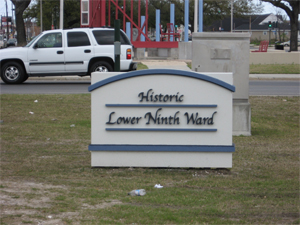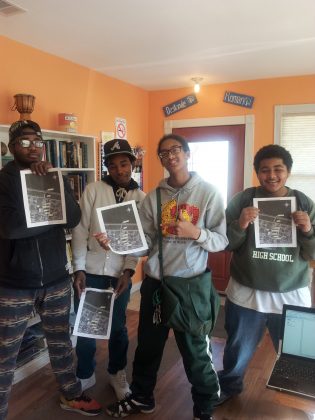Restoring a Watershed One Community at a Time
In a city like New Orleans, community is everything. Walking down the street, people used to speak to passers by, and everyone kept an eye out for one another. Prior to Hurricane Katrina, everyone was each other’s neighbor. Walking around the Lower Ninth Ward meant passing several homes on every block. Today it means visiting one, maybe two, houses per block. As a result, a sense of community has disappeared from the area. With very few residents returning to the Lower Ninth Ward after Hurricane Katrina, many lots stand vacant, some filled with weeds and trash; others still are home only to dilapidated buildings.

The few residents who have returned also gaze out over the ghostly remains of a former cypress swamp. Bayou Bienvenue, once a flourishing freshwater cypress-tupelo tree wetland where community members would hunt and fish, is now an urban swamp decimated by salt water intrusion which killed the vegetation, and weakened protection from high winds and water surges. Loss of the cypress trees made the Lower Ninth Ward more vulnerable to flooding from hurricanes. Without the natural barrier protection provided by the Bayou, a daily downpour can instantly incapacitate neighborhoods with floods.
Helping Heal the Environment
For Lower Ninth Ward residents, there is a movement afoot to, in a sense, take back the streets through improved stormwater management. With the help of an EPA Environmental Justice Small Grant, Groundwork New Orleans assessed community needs to address issues of stormwater management, ecosystem restoration, and quality of life. In the midst of the assessment, a common theme was recognized: lack of communal connection. Residents had simple requests like planting more flowers to attract butterflies back to the area. As a result, a rain garden was installed to mitigate flooding and grew into a beautiful green space for neighbors to gather and get to know one another.

Central to this process was engaging local residents in identifying solutions. For example, Lower Ninth Ward residents’ needs and input were instrumental in creating a site that removes toxins from stormwater and provides an educational and beautiful space for residents to enjoy. A corner lot at Caffin Avenue and North Prieur Street was selected to create a rain garden and community beautification site. Located near the Industrial Canal levee breech that inundated the neighborhood during Hurricane Katrina, the site contains a shade structure, rain garden, native plants, fruit trees, benches, and educational signage. After a few months, the site has become a communal space where neighbors can feel welcomed, and that helps alleviate street flooding and improve watershed health along with the neighborhood aesthetic.

Members of Groundwork New Orleans’ Green Team are a part of the process from start to finish. Green Team members learn about research methods, public speaking, community engagement, science, construction, and water testing. The students are gaining valuable life skills while making improvements in their community, like using GIS mapping to plot drainage problem areas along Caffin Avenue and conducting water quality testing in Bayou Bienvenue. The results compiled from these activities were presented to neighborhood residents and organizations. At each workshop, the Green Team leads a hands-on activity to share what they have learned and educate the community.
The restoration of Bayou Bienvenue is an important part of rebuilding the community because the Bayou provides opportunities for fishing, canoeing, and other activities for local residents. Engaging the community in understanding how a neighborhood-level watershed and habitat design can reduce susceptibility to flooding is helping to usher in a sense of communal connection so that the community heals while helping to heal the environment—now the focus of an EPA Urban Waters grant.
Lessons Learned
- The best place to start is with community members and their feedback.
- Local residents are important voices/advocates for change.
- Local nonprofits have to work together in order to truly empower the community.
- Know or be willing to research and learn the history and culture of a community prior to attempting a project.
Future Vision
Groundwork New Orleans and EPA continue to work on stormwater management in the community. Even years after Katrina, local residents are informed and empowered to continue to heal the environment and clean up and beautify areas around them. In 2014, Groundwork New Orleans received both an EPA Urban Waters grant and an EPA Environmental Justice Collaborative Problem-Solving grant to support the work identified by the community such as creating more green infrastructure features on the site, a “Don’t Dump Dat” campaign, stakeholder coalition building, tree and flower plantings, community cleanups, and stormwater management education workshops in the area.
Additional Background
The green infrastructure work was funded in part by a $100,000 grant from the NOLA Sewerage and Water Board.
